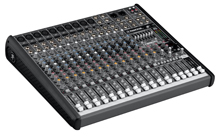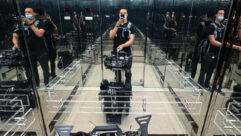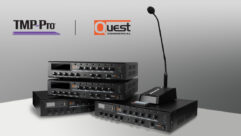

Mackie ProFX16 Mixer
May 25, 2012 12:43 PM,
Reviewer: John McJunkin
Its USB I/O opens up new possibilities.
A client for whom I recently did a conference room redesign and upgrade specified that the company would like for the conferences to be made available for live streaming over the Internet. Routing all the necessary signals and processing them in preparation for streaming wasn’t terribly difficult, but getting the audio signal into a server was something I hadn’t really considered prior. And even that’s not super complex or expensive, but the thought struck me: what if there were a mixer that facilitated signal routing, equalization, recording and playback, and also connected to the IP world via USB? I would very strongly consider using such a mixer for an application like the install mentioned above. As I pondered that, I recalled that there are indeed manufacturers offering mixers with digital I/O via USB and FireWire. I searched the Internet for mixers like this, and discovered that Mackie has introduced a series of them—the ProFX series. There are four mixers available in this series, with eight, 12, 16, or 22 inputs.
The major standout feature common to all four models is USB connectivity with computers, and a built-in effects processor with 16 useful and common effects programs. I evaluated a ProFX16, which offers 10 input channels with mic preamplifiers. Those same channels can be configured for line level inputs by changing the gain level; this yields up to eight mono and four stereo line inputs. All input channels feature 60mm faders, bus selection, PFL, and mute buttons, pan knobs, three auxiliary sends (Mon 1, Mon 2, and the internal effects send), three-band EQ with sweepable mids on channels 1-8, a 100Hz, 18dB/octave high-pass filter, and gain knobs. The EQ mids are not sweepable on the stereo-paired inputs (9/10, 11/12, 13/14, and 15/16). The low band is fixed at 80Hz across the board, and the high band at 12kHz. The range of the sweepable mids is 100Hz to 1.5kHz, and the non-sweepable mids are fixed at 2.5kHz. A stereo graphic EQ is also built in to the mixer, adjustable at 125Hz, 250Hz, 500Hz, 1kHz, 2kHz, 4kHz, and 8kHz. All EQs can boost or cut by 15dB. Each channel’s output can be routed to any or all of four subgroups and/or the mixer’s main stereo bus. Via the L-R assignment buttons above each subgroup’s master fader, stereo subgroups can be created (for drums or other groups that have a stereo image).
Above the subgroup and main faders are auxiliary master level knobs for the three auxes, three auxiliary return level knobs (to Mon 1, Mon 2, and stereo bus), and return levels for the internal effects (also to Mon 1, Mon 2, and stereo bus). A rotary input knob steps through the 16 built-in effects, but it threw me off a bit—it doesn’t “wrap around;” preset 16 is at the far right end, and preset 1 is at the far left; you can’t “go around the horn” back to the bottom. This isn’t a deal breaker by any stretch; it’s just a little unexpected. There’s a level knob for the two-track return, and a button to determine whether it’s fed by the RCA tape inputs or the USB bus. Another button determines whether the stereo bus or subgroups 1 and 2 are fed to the USB output.
In addition to the knob that determines the level to the control room outputs and headphones, there is a very clever and useful button that struck me as a why-didn’t-I-think-of-that notion: a “break” button. At the end of a band’s set, the break button can be pushed to instantly mute all inputs. A 12-segment stereo LED meter shows the main output level, and a single pushbutton toggles 48V phantom power on and off. And, of course, Mackie’s standard “rude” solo LED lives right below the meter. A pushbutton determines whether the Mon 1 channel or the stereo bus is routed through the seven-band graphic EQ, and another pushbutton bypasses the EQ altogether. This threw me off a bit as well. When it’s depressed, the EQ is bypassed, and when it’s up, the EQ is engaged. This not what I’m accustomed to, but it’s not a big deal.
The first eight inputs feature balanced XLR mic and TRS line-level inputs (balanced or unbalanced). Stereo inputs 9/10 and 11/12 feature balanced monophonic XLR mic inputs and mono or stereo balanced or unbalanced TRS line-level inputs (mono signals are plugged into the left input). There are also TRS outputs for Mon 1 and Mon 2, an effects send, control room monitors, four subgroups, and stereo headphones. There are TRS stereo bus outputs, along with the primary XLR stereo bus outputs. There are also TRS auxiliary return inputs. Stereo RCA pairs represent tape input and output, and the only other I/O connector on the console is the USB port on the rear panel.
Mackie ProFX16 Mixer
May 25, 2012 12:43 PM,
Reviewer: John McJunkin
Its USB I/O opens up new possibilities.
Aside from the USB I/O and great sounding 32-bit digital effects, the other major standout feature of this mixer is the existence of compressors on input channels 5-8. I produce podcasts for a living, and I consult clients on the development of simple podcast production studios in their homes and offices. I’m often asked what one thing makes the podcast sound professional more than any other factor. The answer is usually “compression” because it lends a broadcast-like sheen to the podcast, and helps to tame unruly speech levels and facilitates a higher output level, psycho-acoustically speaking. These compressors are also simple for the end-user who’s not accustomed to the various parameters of a typical compressor—just a single knob that controls threshold. The ratio is fixed at 6:1, and the compressor exhibits soft-knee performance for a smoother onset. This feature truly does lend a more professional sound for both spoken word and singing, and it sounds quite good.
To my ear, this mixer sounds good all the way around. The fixed EQs are placed at appropriate and musical frequencies, and the cut and boost don’t feel quite linear to me – there seems to be quite a bit of grab right from the start, which is preferable in my book. I don’t want to have to get close to the end of the knob’s throw before substantial boost or cut becomes blatantly audible. The mic pres sound great too. If I had my druthers, I’d love to see analog inserts on the stereo bus outputs like there are on the first four channels. De facto digital inserts exist via clever signal routing – send signal out from subgroups 1 and 2 via USB to any processing you’d like on your computer (bearing in mind that there will be latency, of course) and return it via USB to your analog stereo bus. This is probably only useful for a suite of “mastering” type processing on the stereo bus – EQ and dynamics, or maybe even multi-band dynamics, but it’s useful nevertheless. And of course, that same stereo signal can be recorded by your computer with virtually any recording software. Mackie includes its Tracktion 3 software, which I’ve always really liked, largely due to its support of VST and VSTi plug-ins.
The Mackie ProFX16 is a big step forward for Mackie with the inclusion of USB digital I/O and built-in compression (the compressors are only available on the 16- and 22-input versions). I really like this little mixer, and considering the features, the price is right. Overall, this mixer represents a good value, and will open up new possibilities with its USB I/O.
Product Summary
Pros: USB I/O, onboard effects, compression on four inputs, break button.
Cons: Signal bleed through stereo bus, effects rotary selector does not “wrap around”, graphic EQ bypass button not intuitive (depressed=bypassed, up=engaged)
Applications: Corporate AV, restaurant, club, small venue PA, portable sound
Price: $499.99 MAP
Specifications:
Noise characteristics (20Hz-20kHz, 150Ω, EIN)
Mic in to insert send out, max gain: -128.0dBu
All outputs, master levels off, all channel levels off: -95 dBu
All outputs, master levels unity, all channel levels off: -85 dBu
All outputs, master levels unity, 1 channel level unity: -85 dBu
Frequency response (mic input to any output, unity gain): 20Hz – 20kHz
Distortion (THD+N, 20Hz- 20kHz, mic in – main out): <0.01%@+4 dBu output
Attenuation and Crosstalk (20Hz-20kHz bandwidth)
Adjacent Inputs @ 1kHz: -90dBu
Fader off @ 1kHz: -75dBu
Mute switch/break switch mute @ 1kHz: -100dBu
Common mode rejection ratio (CMRR)
(Mic in to main out, channel gain at max: 50 dB @1 kHz): 70dB
Maximum Levels
All inputs: +22 dBu Main mix XLR: +28 dBu
All other outputs: +22 dBu
USB
Format: USB 1.1
I/O: Stereo in & out
A/D/A: 16-bit, 44.1kHz or 48kHz
Input and Output Impedance
Mic In: 3.3kΩ
Channel insert return: 10kΩ
All other inputs: 20 kΩ
Tape out: 1 kΩ
Phones out: 25Ω
All other outputs: 120Ω
AC Power Requirements
Power Consumption: 40W (ProFX16); 45W (ProFX22)
Universal AC power supply: 100-240VAC, 50-60Hz
Power connector: 3-pin IEC
Physical Dimensions and Weight
Front height: 1.7in./44 mm (both)
Rear height: 3.8in./97 mm (both)
Depth: 16.0in./407 mm (both)
Width: 18.7in/475mm(ProFX16); 25.1in/639mm(ProFX22)
Weight: 13lb./5.9kg (ProFX16); 18lb./8.2kg (ProFX22)
John McJunkin is the principal of Avalon Podcasting in Chandler, Ariz. He has consulted in the development of studios and installations and provides high-quality podcast-production services.










